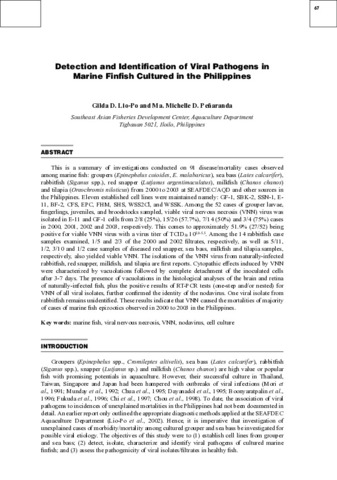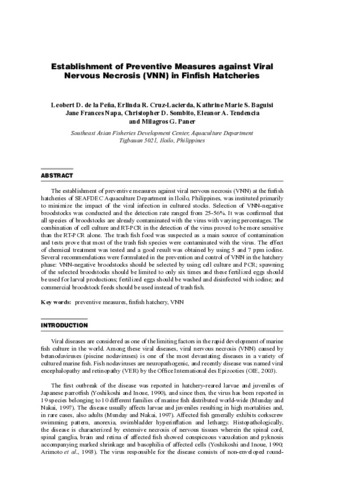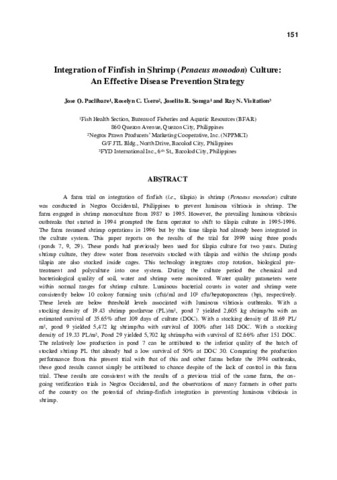Finfish immunology and its use in preventing infectious diseases in cultured finfish
| dc.contributor.author | Evelyn, Trevor P. T. | |
| dc.contributor.editor | Lavilla-Pitogo, Celia R. | |
| dc.contributor.editor | Cruz-Lacierda, Erlinda R. | |
| dc.date.accessioned | 2021-11-09T16:11:29Z | |
| dc.date.available | 2021-11-09T16:11:29Z | |
| dc.date.issued | 2002 | |
| dc.identifier.citation | Evelyn, T. P. T. (2002). Finfish immunology and its use in preventing infectious diseases in cultured finfish. In C. R. Lavilla-Pitogo & E. R. Cruz-Lacierda (Eds.), Diseases in Asian aquaculture IV: Proceedings of the Fourth Symposium on Diseases in Asian Aquaculture, 22-26 November 1999, Cebu City, Philippines (pp. 303-324). Fish Health Section, Asian Fisheries Society. | en |
| dc.identifier.isbn | 9718020160 | |
| dc.identifier.uri | http://hdl.handle.net/10862/6222 | |
| dc.description.abstract | This review draws heavily on knowledge and experience gained from studies on cultured finfish, particularly salmonids. The advantages of using the finfish immune system as a means of protecting them against infectious diseases compared to that of chemotherapy and chemoprophylaxis are underlined. The ontogeny of the immune system and its significance relative to attempts to vaccinate finfish are described. Important components of the immune system (both reticuloendothelial and lymphoid) responsible for the humoral and cellular responses and the memory response are considered as are some of the more important factors (fish age/size and water temperature) affecting the performance of the system. Types of vaccines used or being considered for use for preventing important bacterial and viral finfish diseases and for maximizing vaccine efficacy (level and duration of protection) are described. Methods of administering vaccines (injection, immersion, feeding) are outlined and the advantages and disadvantages of the various vaccine delivery systems are discussed. The importance of identifying the virulence factors produced by bacterial and viral pathogens and of using growth media that allow satisfactory expression of these factors is stressed. These factors form the basis of all vaccines and are of pivotal importance with the newer genetically engineered and DNA vaccines which, thus far, have focused on only one factor per vaccine. Finally, the possibility and utility of providing short-term (passive) protection to larval finfish by immunization of their mothers are discussed. | en |
| dc.publisher | Fish Health Section, Asian Fisheries Society | en |
| dc.subject | Finfish | en |
| dc.subject | immune system | en |
| dc.subject | bony fishes | en |
| dc.subject | humoral immunity | en |
| dc.title | Finfish immunology and its use in preventing infectious diseases in cultured finfish | en |
| dc.type | Conference paper | en |
| dc.citation.spage | 303 | en |
| dc.citation.epage | 324 | en |
| dc.citation.conferenceTitle | Diseases in Asian aquaculture IV: Proceedings of the Fourth Symposium on Diseases in Asian Aquaculture, 22-26 November 1999, Cebu City, Philippines | en |
| dc.subject.asfa | fish culture | en |
| dc.subject.asfa | infectious diseases | en |
| dc.subject.asfa | fish diseases | en |
| dc.subject.asfa | immunology | en |
| dc.subject.asfa | vaccination | en |
Files in this item
| Files | Size | Format | View |
|---|---|---|---|
|
There are no files associated with this item. |
|||
This item appears in the following Collection(s)
-
Diseases in Asian aquaculture IV [43]
Proceedings of the Fourth Symposium on Diseases in Asian Aquaculture, 22-26 November 1999, Cebu City, Philippines




